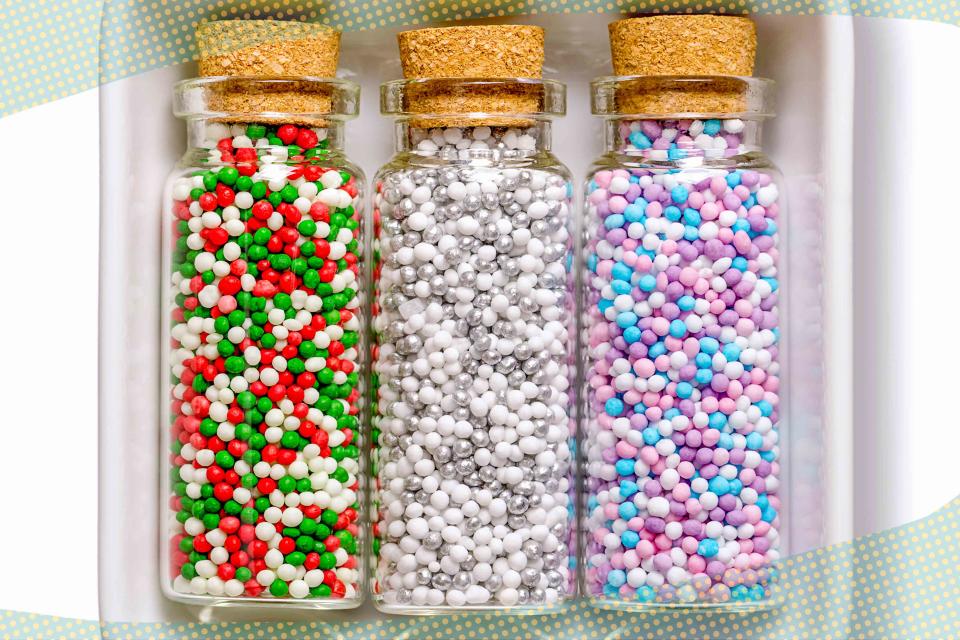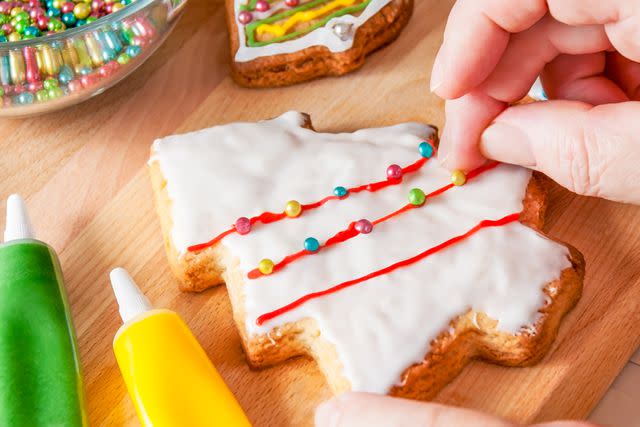Ummm… What Do You Mean by “Nonpareil”?
If you’ve always wondered, we have the answer.

Simply Recipes / Photo Illustration by Wanda Abraham / Getty Images
Decorating Christmas cookies was a big deal for me when I was young. It was a giant mess, too, because my use of colored sugar, chocolate sprinkles, cinnamon red hots, and those teeny-tiny multicolored balls was unfettered. A few tubs of those decorations had “nonpareil” on the label, which I never thought much about, because I was probably too immersed in decorating cookies.
A few weeks ago I came across a recipe calling for nonpareil capers. Capers are the salty pickled flower buds of a Mediterranean shrub, which is a far cry from sprinkles. What did these things have in common? Suddenly I was curious why the labels of both featured this little-seen word.
From Archaic French to Cookie Decorations
According to Wiktionary, nonpareil derives from the Late Middle English non-parail (“unparalleled”), which in turn comes from the Middle French nonpareille. It’s pronounced non-PAH-rehl (not non-par-EEL, which is how I clumsily said it). Sometimes it’s spelled non-pareil or non pareil.
Here’s what Merriam-Webster had to say in a blog post about it: “In English, nonpareil means ‘having no equal’ or ‘a small flat disc of chocolate covered with sugar sprinkles’.” As if that’s even helpful! Why would small flat chocolate discs covered with sprinkles have a name that means having no equal?
Merriam-Webster goes on to say “The ‘chocolate candy’ sense originated in the name of a small almond candy, covered in hardened sugar, which was known in France in the late 1600s and mentioned in Madame Bovary (1857), but this meaning of the word has fallen completely from use in French.”
Confusingly, the tiny spherical sprinkles themselves are also called nonpareils. You can see a large selection of examples of the chocolate discs covered with the tiny nonpareil sprinkles over at the web store Candy Nation.

Getty Images
Other Names for Nonpareil Sprinkles
In other parts of the English-speaking world, nonpareils are called hundreds and thousands. If you’ve ever accidentally over a container of these sprinkles, you know this name is quite apt.
Are other types of sprinkles, like the popular rod-shaped funfetti ones formerly known as jimmies, also nonpareils? Generally no, but there’s no entity policing this stuff.
What About Capers?
Here’s where capers fall into all this. Capers come in different sizes, and the most common size found in stores in North America is known as nonpareil. If a recipe calls for nonpareil capers, it’s likely referring to the kind of jarred, pea-size capers you already have on hand.
Read More: What Are Capers?
So, in conclusion, little round things or candies covered in little round things are sometimes known as nonpareils. It can also refer to a size of caper. Are any of these things truly without equal? That’s up to you, dear reader.

Getty Images
Bonus: Are Dragees Edible?
I figured as long as we’re on the topic of obscure terms for cookie decorations, we might as well touch on those metallic (usually silver) balls that appear in greater abundance at the holidays. They, too, fall under the umbrella of nonpareils. I was fascinated by these things as a kid.
Officially they are called dragees, and for years their bottles in the U.S. have sported the warning “For decoration only”. Are they poisonous?
Well, they’re not good for you, but neither are cookies. According to cake decorating supply superstore NY Cake, “Dragees are non edible decorations and are for adornment purposes only.” As a living child of the 1980s, I can vouch that eating dragees will not kill you. In fact, for dragees to put you in mortal peril you’d need to swallow so many you’d have a giant stomach ache regardless. Go ahead and indulge on a nonpareil dragee or two this holiday season. Their rarity is what makes them special.
Read the original article on Simply Recipes.

